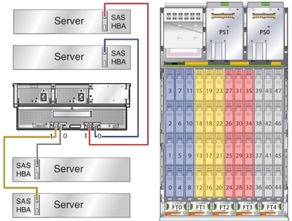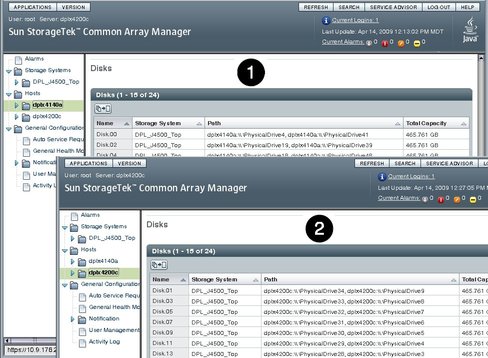| Skip Navigation Links | |
| Exit Print View | |

|
Sun Storage J4500 Array System Overview |
Overview of the Sun Storage J4500 Array
Exterior Features, Controls, and Indicators
Sun Storage J4500 Array Rack Slide Rails
To Place the Array Into Standby Power Mode
AC Power Failure Auto-Recovery
Updated Driver Files Required for Windows
Clustering Software Not Supported With the J4500 Array
Management Options When Using the StorageTek SAS RAID External HBA (Adaptec-Based)
Management Options When Using the StorageTek SAS External HBA (LSI-Based)
Using the Common Array Manager Software
Viewing Sun Storage J4500 Array Information With CAM
Zoning Array Storage Resources Using CAM
Upgrading Sun Storage J4500 Array Firmware Using CAM
Using the StorageTek RAID Manager Software
Viewing Sun Storage J4500 Array Information With the Sun StorageTek RAID Manager
3. Adding and Zoning Array Storage Using CAM
Access Configuration (Zoning) Guidelines
Adding (Cascading) a J4500 Array to An Existing Zoned J4500 Array
To Prepare an Existing Array Prior to Cascading Additional Storage
To Prepare a New J4500 Array for Cascading
Configuring Multiple Host Access for a J4500 Array
To Configure Multiple Host Access for a J4500 Array
Supported Sun Storage J4500 Array Firmware and Common Array Manager (CAM) Software
Supported Operating Systems and Drivers
Supported Drives for Multipath
Multipathing Configuration Guidelines
Multipathing With One Host, One HBA and One Array
Multipathing With One Host, One HBA and Cascaded Arrays
Multipathing With One Host, Two HBAs and Cascaded Arrays
Multipathing With Two Hosts, Four HBAs and Cascaded Arrays
Multipathing With Two Hosts, Multiple HBAs and Cascaded Arrays
Enabling and Disabling Multipathing in the Solaris Operating System
To Enable Multipathing on LSI-Based Multipath-Capable Controllers
To Disable Multipathing on LSI-Based Multipath-Capable Controllers
Configuring Multipathing on Selected Ports
Enabling and Disabling Multipathing in the Linux Operating System
To Enable Multipathing in Linux
To Disable Multipathing in Linux
Enabling and Disabling Multipathing in the Windows Operating System
How a Failover is Handled by Windows
To Enable Multipathing in Windows Server 2008
To Disable Multipathing in Windows Server 2008
To Access Service Advisor Procedures
Taking Electrostatic Discharge (ESD) Precautions
To Reserve the Array for Maintenance
To Release the Array After Maintenance
Understanding the CAM Event Log
Troubleshooting Problems with the Array
Check the Event and Performance Logs
Using the Array Management Software to Monitor Enclosure Health
Resetting the Enclosure Hardware
To Reset the Enclosure Hardware Using the Reset Button
Clearing the Enclosure Zoning Password
Starting with the Sun StorageTek Common Array Manager (CAM) 6.4.1, support for Access Configuration (also known as “zoning”) of the Sun StorageTek J4000 array series (J4200, J4400, and J4500) has been added. Through CAM Access Configuration, you can assign each host (and each initiator in a host) its own storage resources. Accomplished on a per host initiator (HBA) port, per hard-disk level basis, Access Configuration offers the following benefits: storage resource segregation, controlled resource sharing, protection, and topology control.
Sun Storage J4500 Array with Zoned Storage shows a color-coded example of how you might divide the array storage among multiple hosts using zoning. Four connected hosts (on the left), each has exclusive ownership of a specific set of disks allocated to their zone (as indicated by the matching color disks shown in the open cover view of the array on the right). Disks may be zoned in a single array or across cascaded arrays.
Figure 3-1 Sun Storage J4500 Array with Zoned Storage

The dual SAS fabric design of the J4500 array (SAS A and B) is seen in CAM as two separate SAS domains. These domains are zoned separately. In a multipath situation, where you want two initiators to have access to the same disks for failover, each domain, or path, must be configured identically in CAM. CAM provides zoning templates to aid the user in setting up the appropriate configurations, as well as the ability to import and export user-defined templates.
Note - For multipath failover support with zoned disks, you will need to perform Access Configuration in CAM first, and then enable the appropriate multipath driver for your operating system. For information on enabling a multipath driver, refer to Chapter 4, SAS Multipathing.
Two Hosts With Zoned Disks in CAM shows a zoned configuration of the J4500 array's 48 disks with host 1 owning the even number disks, and host 2 owning the odd numbered disks.
Figure 3-2 Two Hosts With Zoned Disks in CAM

 | Caution - In a multipath failover configuration, granting multiple hosts access to the same disks is not supported. Only single host, multi-initiator access is allowed. |